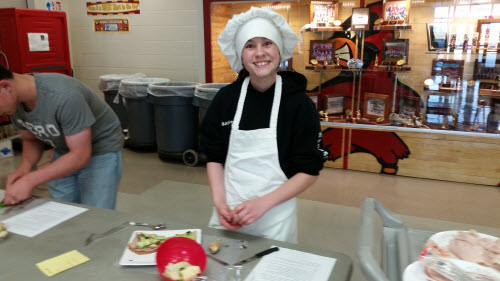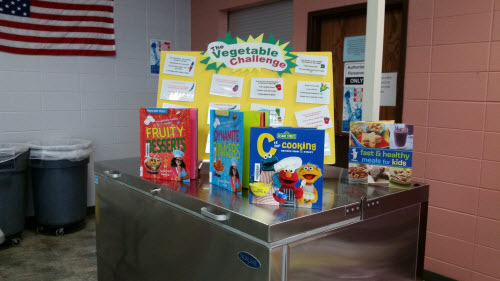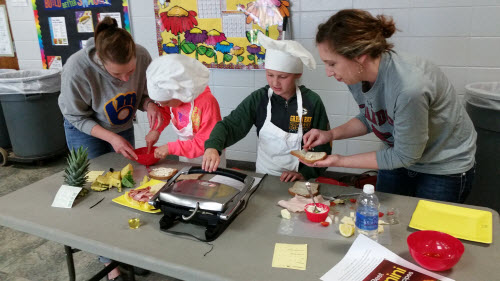Healthy Foods Competition Heats Up at Crandon Public Library
 You can download a PDF of this full story for printing and sharing.
You can download a PDF of this full story for printing and sharing.
Crandon Public Library is located in Crandon, Wisconsin, and serves a community of 6,054. Primary partners for this event included the Forest County Health Department Council on Activity and Nutrition, the School District of Crandon, and Forest County Ties that Bind Us, a local nonprofit organization.
Community Engagement
Crandon Public Library and its partners hosted a community cooking competition—Iron Chef—to promote healthy recipes and ingredients. Using space at the local school cafeteria, participants were given 30 minutes to create a unique panini dish, using the secret ingredient of eggplant and other pantry items. Participants competed in three categories: adults (18+), teens (12–17) and youth + adult (11 and younger). Local restaurant owners participated as celebrity judges. The library was able to display more than 25 related items from its collection as part of the event. Fifteen competitors developed culinary creations, and each took home a panini maker donated by the local health department. The grand-prize winner took home a Ninja® blender, donated by the local nonprofit partner.
Organizing the Event
As Director of Crandon Public Library, Michelle Gobert takes a proactive approach to community health matters in the close-knit community. She serves as a member of the Forest County Community Coalition, comprised of community stakeholders from multiple organizations that meet monthly to discuss ways to build and support a healthy county. Michelle also stays connected to the county health department planning efforts, through which the local health department develops data-driven priorities for community health every five years.
Through this strong network of existing relationships, Michelle, the library’s three full-time staff members and community partners were able to efficiently plan and deliver a whole new community educational experience centered on healthy foods.
Factors that contributed to this successful event included:
- Promotion through multiple channels: The library regularly invests in marketing through its website, local newspaper, flyers and social media. Staff prioritize promotional activities on a weekly basis. In addition to promoting the event using these standard channels, staff and partners promoted their event through individual conversations in the community, and encouraged registration at a health fair the school district held a week prior to the Iron Chef competition.
- Focusing on the participant experience: Everyone involved in planning took a very hands-on approach, including shopping for and prepping fresh ingredients. Before the event, planners walked through the participant experience from start to finish, and considered details that ultimately made it a success. These included how to set up the cafeteria space; what rules would be provided in advance; and the criteria used for judging. Thinking about all aspects of the participant experience enabled community members to connect, engage and learn in an atmosphere of positive collaboration.
Michelle shared the following tips for libraries interested in planning their own community health activities:
- Know your community’s health status: Many resources exist that provide data on community health status and priorities. Look at the data or priorities your local health department is collecting and working with. Use this information as a starting point to build relationships and consider program ideas.
- Join the conversation: Local health departments or other community networks may seek public representation on planning councils, outreach committees or other forms of collaborative planning and decision-making related to health. Identify these opportunities in your community, and, as time or capacity allows, find ways for your library to contribute. This could include anything from attending regular meetings, to tracking email or listserv communications and providing input when it’s asked for.
- Be prepared to tell your library’s story from a community outcomes perspective: Think explicitly about how supporting community health reinforces the broader vision, mission or intended outcomes of your library. Develop some concrete statements around this. Provide this context to new partners, as other community organizations may have a limited perspective into the scope or potential of library services, and are likely to be positively surprised when you help them see clear intersections in your goals regarding a healthy and engaged community.
Looking Forward
The library and event partners are exploring future opportunities to promote intergenerational activities together. The local school serves grades K–12, and the library is excited to continue to work with the school to meet the needs of the students, teachers and their families. This event represents a shared success to inform future programming among the library, the school and the local health department.
According to Michelle, “This event built bridges across multiple dimensions of our community. We worked with our partners to explore shared outcomes for this event, which allowed us to plan together efficiently. Thinking about our health programming in terms of outcomes, and our ultimate commitment to expand our patrons’ worlds, also allows us to tell our library’s story in a compelling way.”


